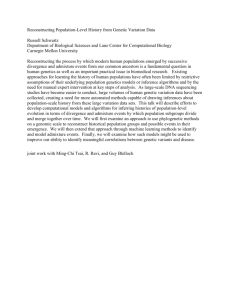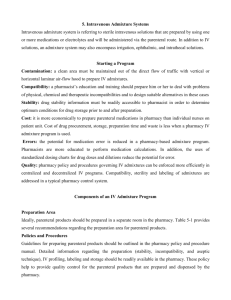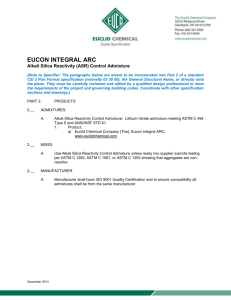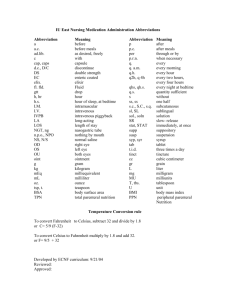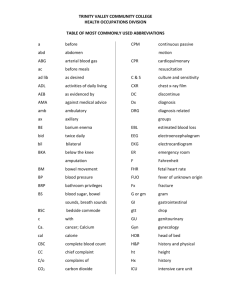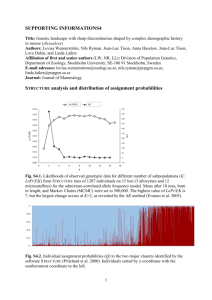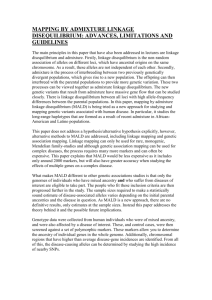Intravenous Admixture System - Home
advertisement
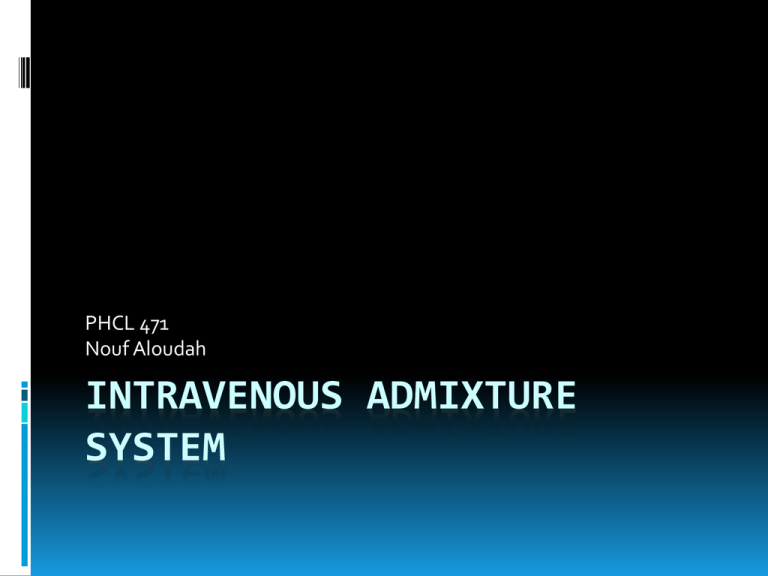
PHCL 471 Nouf Aloudah INTRAVENOUS ADMIXTURE SYSTEM Intravenous Admixture System Hospital pharmacist have been involved with the preparation of parenteral dosage forms for several decades Was only compounding sterile intravenous, intrathecal, ophthalmic, and irrigating solutions that were not available commercially Intravenous Admixture System Parenteral comes from a geek words “para” and “enteron” =outside the intestine Injection medication into veins and through subcutaneous tissue Intravenous Admixture System The first needle was made from a quill attached to an animal bladder Lack of aseptic techniques and sterile, pure drugs causer failure in parenteral therapy until 19th century Intravenous Admixture System Through effort of Pasteur and others (Lister, Koch, Jenner, Hunter and Seibert) aseptic technique, bacteriologic filtration methods, and pyrogen free diluents were developed Gained recognition by the national formulary and U.S. pharmacopeia (USP) Intravenous Admixture System 40% of hospital inpatients receive IV preparations (and it is continue raising!) replacing fluids and electrolytes, provide nutrition and administer medication Intravenous Admixture System It can be provided to the patient in his/her home Many hospitals involved in compounding IV solutions and medications to outpatient settings Pharmacist as “ parenteral therapy expert” Today’s graduates are expected to know how to compound parenteral solutions to meet a patient’s clinical needs Must be ware of both stability and compatibility of drugs administer by the IV route Intravenous Admixture System in addition to the basic techniques for compounding oral, rectal, and topical dosage forms, pharmacist is also expected to be proficient in compounding parenteral dosages and to ensure that they administered and monitored correctly Intravenous Admixture System Today’s lecture presents the fundamentals of a pharmacy directed IV admixture programs and information about several types of IV admixture systems Admixture system” refers to sterile IV solutions that are prepared by using one or more medications or electrolytes and will be administered via the parenteral route Admixture also could be irrigation, ophthalmic, and intrathecal solutions Intravenous Admixture System STARTING A PROGRAM Rationale Started with preparation of solutions not available commercially 1971 FDA along with the USP established the National Coordinating Committee on Large Volume Parenteral (NCCLVP) To identify problems associated with large parenteral in hospitals (LVPs) Developed procedures to be used by hospital personnel for preparing and administering LVPs It is no longer exist Intravenous Admixture System STARTING A PROGRAM Rationale The NCCLVP important standards of practice that are still used today: 1. Recommended methods for compounding IV admixtures in hospitals 2. Established a system for the surveillance and reporting of problems with LVP’s in hospitals 3. Proposed test methods for particulate matter in LVP’s 4. Set forth recommendations for labeling of LVP’s and 5. Recommended procedure for in use testing of LVP’s suspected of contamination or of producing a reaction in a paient Intravenous Admixture System STARTING A PROGRAM Rationale NCCLPV no longer exist, committees for hospital accreditation (e.g. American Osteopatic Association, Joint Commission On Accreditation of Healthcare Organizations) has establishes standards of practice for pharmaceutical services Majority of parenteral products are prepared using commercially available medications and diluents solutions but hospital pharmacy department still perform some IV manufacturing Intravenous Admixture System the responsibility of the pharmacy are: Contamination The pharmacy must maintain a clean area out of the direct flow of traffic with a vertical or horizontal laminar air flow hood to prepare IV admixtures Intravenous Admixture System the responsibility of the pharmacy are: compatibility A pharmacist education should prepare him/her to deal with problems of physical, chemical, and therapeutic incompatibilities and to design suitable alternatives when these problem arise Intravenous Admixture System the responsibility of the pharmacy are: Stability Drug stability information must be readily accessible to the pharmacist in order to determine optimum conditions for drug storage prior and after preparation The stability of a drug at ideal storage conditions will help to establish a reasonable expiration date for the product Product sterility, overall integrity also inspected Intravenous Admixture System the responsibility of the pharmacy are: Cost Preparation in the pharmacy is more economically than individual nurses on a patient unit The overall cost of drug, diluents procurement, storage, preparation time, and waste is less in pharmacy based admixture program Nurse based program needs coordination of efforts to obtain drugs from the pharmacy as well as diluents solutions from central supply Intravenous Admixture System the responsibility of the pharmacy are: Cost (cont’) In pharmacy frequently administered medications can be obtained in bulk containers which decreases drug procurement cost, and can be prepared in batches, which decreases both labor and waste Nursing time associated with administration to patients is minimized The amount of unused and wasted parenteral is likely to decrease when a pharmacy IV admixture program is used Intravenous Admixture System the responsibility of the pharmacy are: Errors Reduced in a pharmacy based admixture program It has been less likely for the pharmacist than the other health professionals to make errors in pharmaceutical calculation Standardized dosing charts, showing precalculated drug doses and dilutions, contained in admixture area can also reduced the potential of error Intravenous Admixture System the responsibility of the pharmacy are: Quality Proper polices for inspecting solutions prior to and after preparation are an integral part of pharmacy based programs Policies can be enforced more efficiently in centralized and decentralized pharmacy directed admixture programs Intravenous Admixture System the responsibility of the pharmacy are: Process First pharmacist will determine id dosage, diluents, volume of diluent, and rate of administration are correct Next the label will be checked against the original order The final solution with additives will then be checked against the label to ensure that the proper dose has been prepared “Read the label three times” Intravenous Admixture System the responsibility of the pharmacy are: Total Pharmaceutical care Many patients may be receiving the majority of their medication by parenteral route Centralizing the preparation as well as record keeping function for appropriate review Intravenous Admixture System the responsibility of the pharmacy are: Safety Pharmacy based programs safety is enhanced The JCAHO holds the director of pharmacy services responsible for “preparing, sterilizing and labeling parenteral medications and solutions that are manufactured in hospitals” “the compounding and admixture of large volume parenterals is ordinarily the responsibility of a qualified pharmacist” Intravenous Admixture System Components of an IV program Preparation area Policies and procedures Personnel Storage space Admixture systems Intravenous Admixture System Components of an IV program Preparation area Ideally in separate room in the pharmacy “clean room” Size vary Intravenous Admixture System Components of an IV program Preparation area Intravenous Admixture System Components of an IV program Polices and procedures Guidelines for preparing parenteral products should be outlines in the pharmacy’s policy and procedure manual (we will discuss in coming lectures!) Detailed information regarding preparation, labeling, storage and expiration dating of parenteral products should be readily available in the pharmacy These policy help to provide quality control for the parenteral products Intravenous Admixture System Components of an IV program Polices and procedures Stability Rigorous stability testing by the pharmaceutical manufacturer Independent investigators Put in your mind that stability is affected by place, environmental condition, diluent used to administer the product, other drugs that may be mixed with Stability and sterility! Gives the expiration date Intravenous Admixture System Components of an IV program Polices and procedures incompatibility Physical: visible change e.g. precipitation Chemical: may or not visible change, deterioration or inactivation of an active ingredient Therapeutic: drug-drug or drug-disease interaction that lead to potentiating of drug effect, drug toxicity, deterioration Intravenous Admixture System Components of an IV program Polices and procedures Aseptic Technique Method of handling sterile products, a sterile parenteral dosage form is free from living microorganisms, particulate matter, and pyrogens It refers to the ability of personnel who prepare these IV solutions to handle these products in the clean environment of a laminar or vertical air flow hood without introducing viable microorganisms into the product Hand washing sterile gloves may be used (but watch for false sense of security) Freezing and refrigerating IV solutions helps to prevent bacterial growth Intravenous Admixture System Components of an IV program Polices and procedures IV profiling Reviewed against the patient’s current medication profile Intravenous Admixture System Components of an IV program Polices and procedures Labeling and check systems Reviewed against the patient’s current medication profile Intravenous Admixture System Intravenous Admixture System Components of an IV program Polices and procedures Labeling and check systems (cont’) Continues infusion IV’s requires additional record keeping Integration of the container: leak in bags, cracks in bottles, particulate maters, cloudiness, accuracy of compounding at least two or three times by the person who prepares them as well as by the pharmacist who dispense the item to the patient unit Intravenous Admixture System Components of an IV program Polices and procedures Quality assurance and control A system of checks and balances, aseptic environments, and the pharmacist’s access to booth the patient\s medication profile and the final product provide more stringent quality control over parenteral therapy Routine inspection of all laminar air flow hoods must be performed, routine hood maintaince Intravenous Admixture System Components of an IV program Polices and procedures Quality assurance and control (cont’) Admixture that not available commercially may be prepared from the powder form ex morphine, passing the dissolved drug through a 0.22 micron or 0.45 micron filter will be necessary (not routinely used) Excellent means of trapping but may also adsorb or absorb drug! Don’t filter suspensions, blood and blood products, amphoterecine B, insulin, 10-20 % fat emulsions…. Intravenous Admixture System Components of an IV program Polices and procedures Quality assurance and control (cont’) A typical IV order for a patient would entail the following activities 1. A pharmacy copy of the physician’s original order is prepared, containing the patient’s name, room number, IV fluids, additive(s), and flow rate. 2. The Rx order is entered into the patient’s profile by a pharmacist who checks for drug interactions, proper dose, compatibilities, duplication of medication, allergies, length of therapy and other patient therapies 3. A label is prepared and checked against the original order 4. The parenteral product is prepared by the pharmacist or by an experienced technician, depending on state low Intravenous Admixture System Components of an IV program Polices and procedures Quality assurance and control (cont’) A typical IV order for a patient would entail the following activities 5. The prepared product is then checked against the label and original order by a pharmacist. Dosage, ingredients, auxiliary labels, compatibility, route, rate, absence of particulate mater, discoloration, and container integrity are verified. 6. Upon delivery of the IV product to the patient unit, the solution is once again checked by the person who will be administering the drug 7. Whenever possible, IV admixture should be refrigerated until shortly prior use Intravenous Admixture System Components of an IV program Polices and procedures Auxiliary label There need arise after a potential medication error occurs on the patient-care area Intravenous Admixture System Intravenous Admixture System Components of an IV program equipments Laminar air flow hoods Refrigerator references Intravenous Admixture System Components of an IV program equipments Laminar air flow hoods False sense of security It uses high efficiency particulate air (HEPA) filtration could be horizontal or vertical Hoods do not sterilize an environment but maintain it clean Should be inspected every 6 months Intravenous Admixture System Components of an IV program equipments refrigeration The introduction of a needle into a sterile product is associated with risk of contamination Microbial growth is retarded under refrigeration Needed also I PCU Intravenous Admixture System Components of an IV program equipments References Handbook of injectable drug from ASHP We referenced compatibly and stability charts are also necessary in an IV preparation area (manufacturer) Standardized compounding charts Intravenous Admixture System Intravenous Admixture System Intravenous Admixture System Intravenous Admixture System Components of an IV program equipments References Charts in PCU especially infusion rate, standard medication concentration Intravenous Admixture System Components of an IV program Personnel Carefully trained Who will prepare? Pharmacist or technician Proper training in aseptic technique and sterile product information is necessary (training courses, self study programs Intravenous Admixture System Components of an IV program Storage space Will depend on the type of system one chooses to use In PCU for refrigeration Intravenous Admixture System Components of an IV program Economic considerations Will depend on the type of system one chooses to use In PCU for refrigeration Intravenous Admixture System Intravenous Admixture System Intravenous Admixture System Components of an IV program Admixture system System that requires little or no involvement in the actual “compounding” of dosage forms, it will meet general requirements but not special requirements جيمس أالن ( أنت اليوم حيث أوصلتك .أفكارك ،وستكون غدا حيث تأخذك أفكارك) Intravenous Admixture System Small volume IV infusion Manufacture’s drug packaging Glass ampoules Single dose vials Drug in solution, lyophilized or powdered drugs Multiple dose containers Drug in solution, lyophilized pr powdered drugs Prefilled syringes Intravenous Admixture System IV admixture systems Every system have advantages and disadvantages Premixed products and frozen premixed products offer the least dosing flexibility, but they save pharmacy and nursing labor and also help to decrease waste Others are the most labor intensive to prepare but often have the lowest acquisition cost, more dosing options, wasted doses are greater Intravenous Admixture System IV admixture systems IV infusion control devices New bar coding system Pharmacy have minimal input on perchasing it now they are involved with (PCA) patient controlled analgesia Intravenous Admixture System Specialized admixtures Nutritional chemotherapy عش كل لحظة كأنها آخر لحظة في حياتك، عش باإليمان ،عش باألمل، عش بالحب ،عش بالكفاح وق ّ در قيمة الحياة ... Thank you
